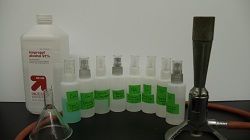![]()
Atomic Structure, Periodic Trends
8.2 Flame Tests 
Subjects: Atomic structure
Description: Alcoholic solutions of salts are burned to illustrate that different wave lengths of light are emitted by different materials.
Materials:
- Meeker burner*
- Lighter*
- Funnel (for alternate procedure)
- Isopropanol/water solutions of:
- Sodium Chloride (NaCl - yellow)
- Strontium Chloride (SrCl2 - red)
- Potassium Chloride (KCl - violet)
- Copper Chloride (CuCl2green)
- Calcium Chloride (CaCl2 red-orange)
- Lithium Chloride (LiCl - red)
- Rubidium Chloride (RbCl - violet)
- Boric Acid (H3BO3 -pale green)
- Blank isopropanol/water
Optional: Spectro-Vis Spectrometer with Emission insert. Used directly with laptop. No intarface needed. Logger Pro software required. Located in the drawers opposite the bin storage shelves.
*Shared item. Located in the top drawer opposite the storage shelves.
Procedure A: Spray Bottles
- Light the burner
- Dim the lights
- Spray salt solution into flame of burner
- Observe colors
- Alternate: point the narrow end of a funnel at the base of the burner. Spray the solutions into funnel, using it to direct the spray into the air intake.
Discussion:
When an element is burned, the electrons are excited. As the electrons from an excited state relax back to a ground state, they will emit photons of light. These photons will have different colors depending on the element and its discrete energy levels. That is, different wavelengths of light (colors) will be emitted when the electrons of different elements go down the step(s) between their energy level(s). Each element will have its own set of steps therefore each will have its own color.
Safety:
Wear safety glasses and goggles while preparing and during the demonstration. Be sure to allow time for the cover to cool before removing. Be sure to keep all other flammable materials clear.
References:
1. NCSU Department of Chemistry Lecture Demo web site http://www.ncsu.edu/project/chemistrydemos/DemoList.html
2. A.M. Landis, M.I. Davies, L. Landis; J. Chem. Ed.; 2009; 86; 577


